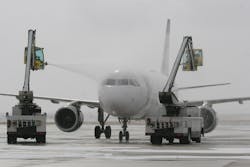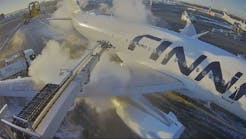The Civil Aviation Administration for China (CAAC) has approved the use of Type IV de/anti-icing fluid for the Chinese market.
Demand for the high performing fluid has increased in China due to the bad weather conditions experienced in winter and approval was granted by the CAAC after stringent testing over a six month period.
The main benefit of Type IV fluid is that it allows for extended holdover times – the time an anti-icing fluid will prevent the formation of frost or ice. This makes multiple re-appliances of the fluid unnecessary. Maximum holdover time is especially important in snow conditions. The fluid is monoproplyene glycol based, making it environmentally friendly and readily biodegradable, as well as non-toxic, non-flammable and easy to handle due to low foaming during application.
Type IV fluid has been used widely throughout Europe and the rest of the world for the past 15 years. Despite winter weather in China being similar to that in North America, the Chinese market currently uses about ten per cent of the de/anti-icing fluid that is used in the US. The approval of the Type IV fluid can help modernise the Chinese approach to de/anti-icing, which so far has centered on Type I and II fluids.
Kilfrost, a global manufacturer of de- and anti-icing fluids for aircrafts and runways, produces the Type IV fluid and is preparing to supply it to China’s aviation industry. Kilfrost services China Eastern Airlines and China Postal Airlines, as well as Shanghai Pudong Airport and Nanjing Lukou International Airport, amongst others.
Kilfrost’s Chief Executive Gary Lydiate commented: “It’s a huge step forward for the Chinese market that Type IV fluid has been approved for use. The new fluid will save airlines time and money by allowing for greater holdover time. We are increasing our production to help meet the demand
Kilfrost has supplied Type I and II fluids to the Chinese aviation industry since 2008 and the company is growing its presence in China.
Lydiate continued: “We have recently signed an agreement with a Chinese partner to produce Type I and II fluids locally. This could make China a base as we grow our operations in Asia. For our customers, it means we can shorten delivery times and respond quickly in adverse weather conditions. ”





